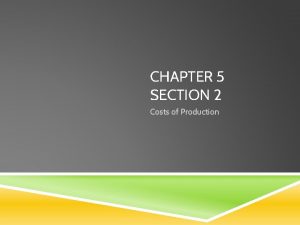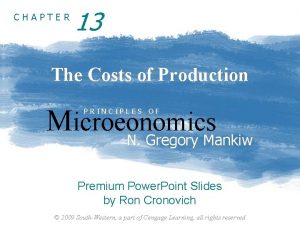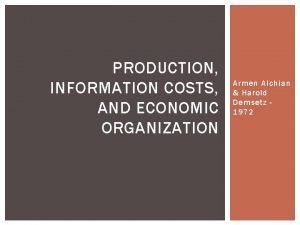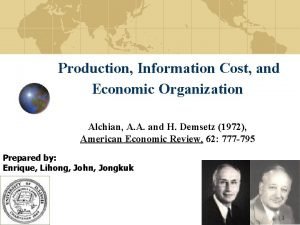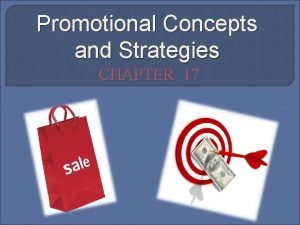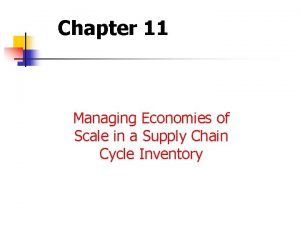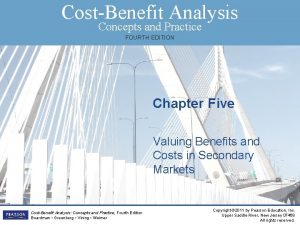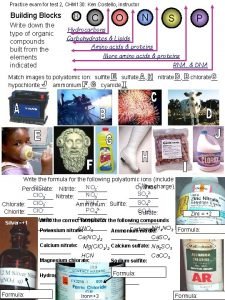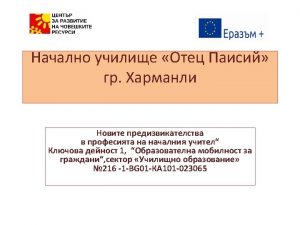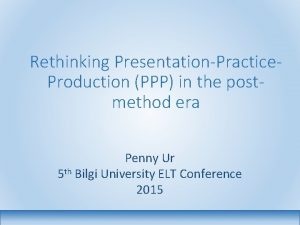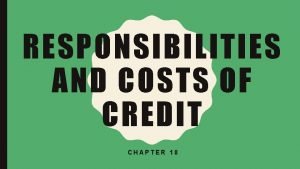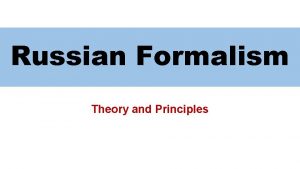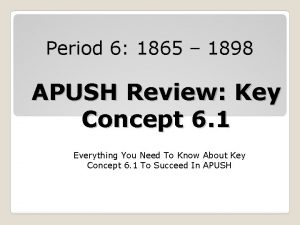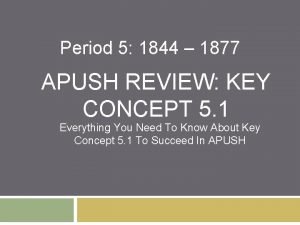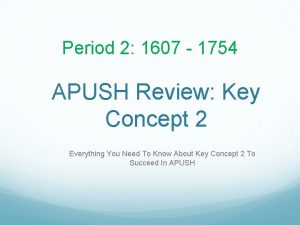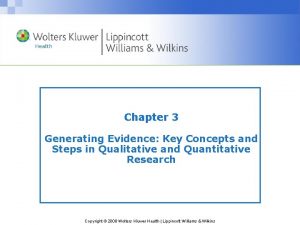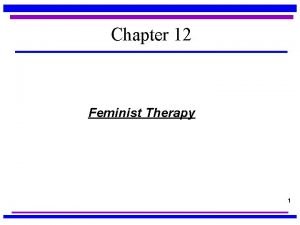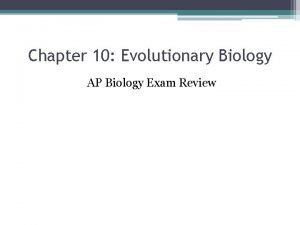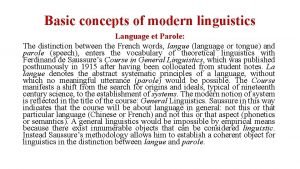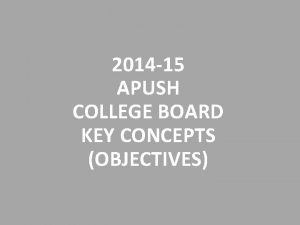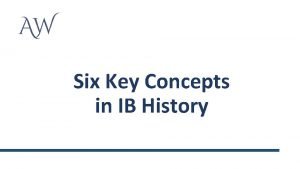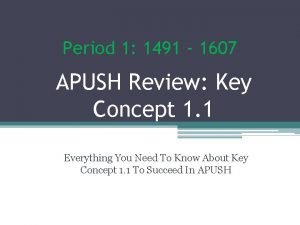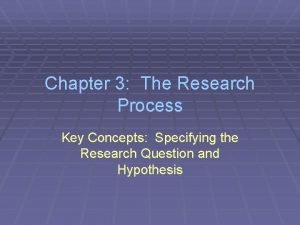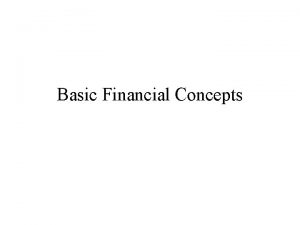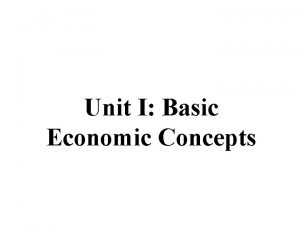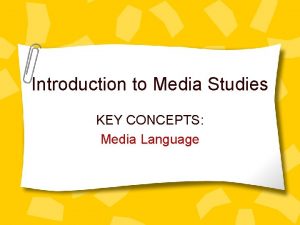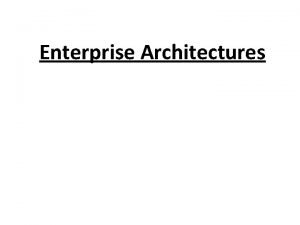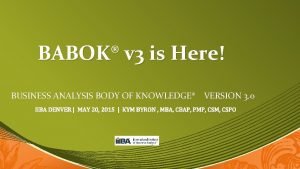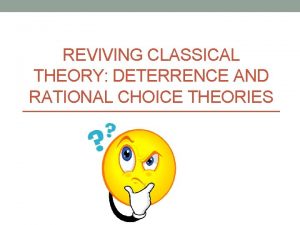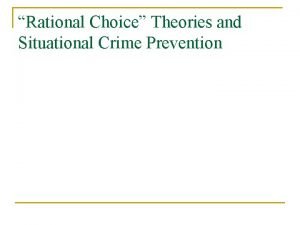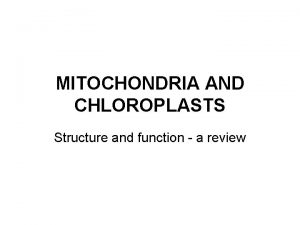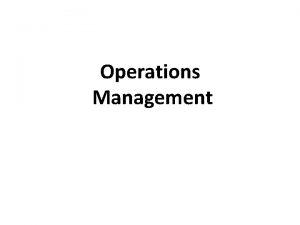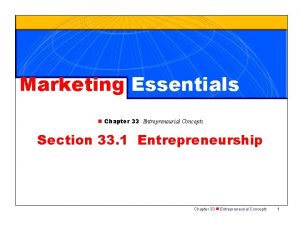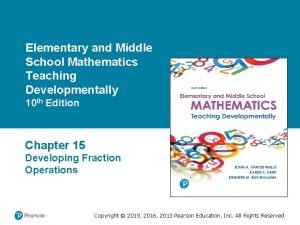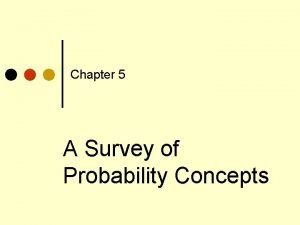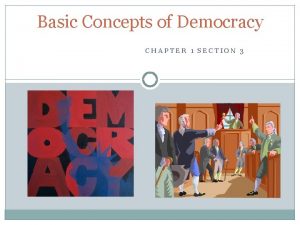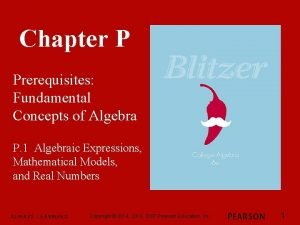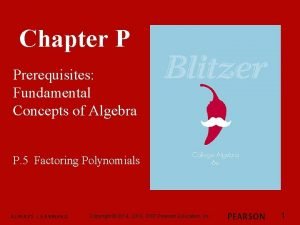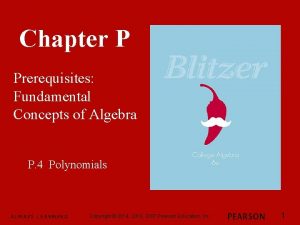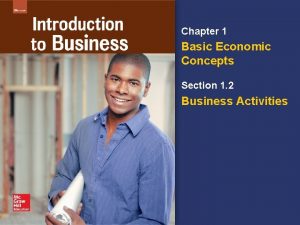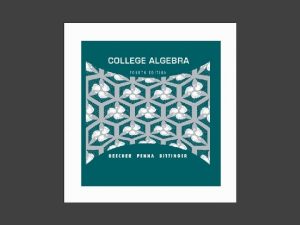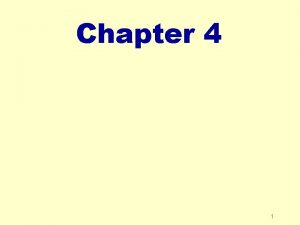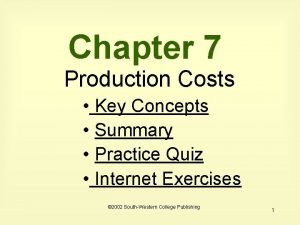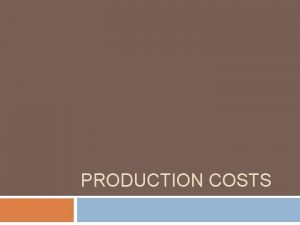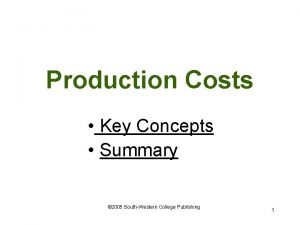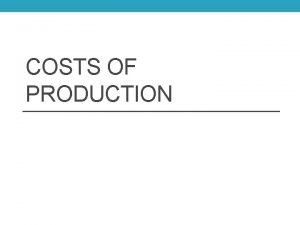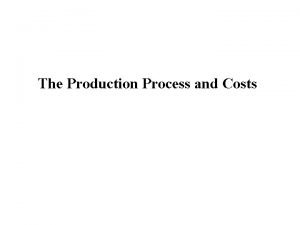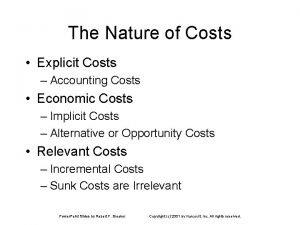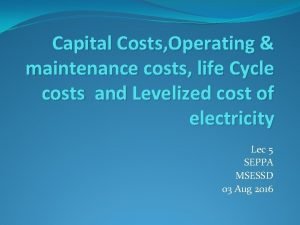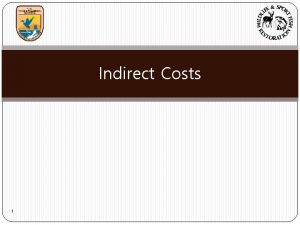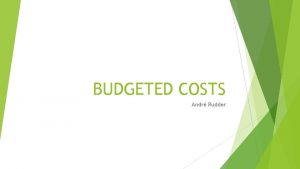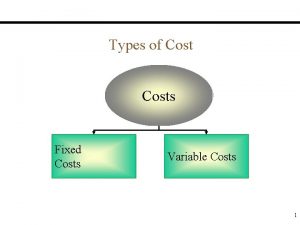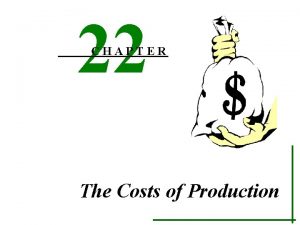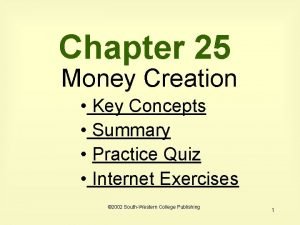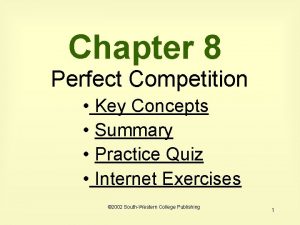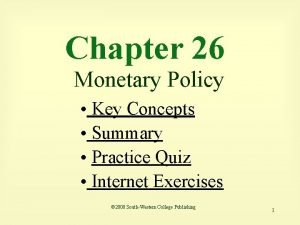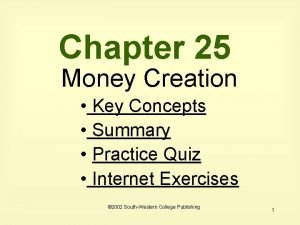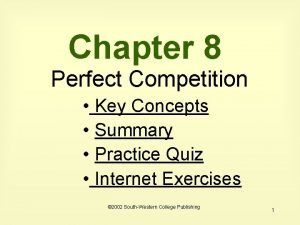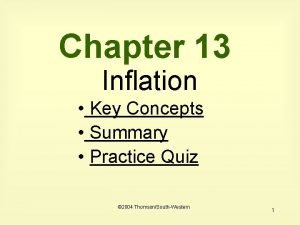Chapter 7 Production Costs Key Concepts Summary Practice




































































- Slides: 68

Chapter 7 Production Costs • Key Concepts • Summary • Practice Quiz • Internet Exercises © 2002 South-Western College Publishing 1

What is a basic assumption in economics? The motivation for business decisions is profit maximization 2

To understand profit, what is necessary? To distinguish between the way economists measure costs and the way accountants measure costs 3

What are explicit costs? Payments to nonowners of a firm for their resources 4

What are implicit costs? The opportunity costs of using resources owned by the firm 5

What is an example of implicit costs? When you invest your nest egg in your own enterprise, you give up earning interest on that money 6

How is accounting profit defined? Total revenue minus total explicit costs 7

What are total opportunity costs? Explicit costs + Implicit costs 8

What is economic profit? Total revenue minus total opportunity costs 9

What is normal profit? The minimum profit necessary to keep a firm in operation 10

When economists use the term “profit”, which profit do they mean? Economic profit which, unlike accounting profit, includes implicit costs 11

What is a fixed input? Any resource for which the quantity cannot change during the period of time under consideration 12

What is the short run? A period of time so short that there is at least one fixed input 13

What is the long run? A period of time so long that all inputs are variable 14

What is a variable input? Any resource for which the quantity can change during the period of time under consideration 15

What is the production function? The relationship between the maximum amounts of outputs a firm can produce and various quantities of inputs 16

What do technological advances make possible? More output is possible from a given quantity of inputs 17

What is marginal product? The change in total output produced by adding one unit of a variable input, with all other inputs used held constant 18

What is the law of diminishing returns? The principle that beyond some point the marginal product decreases as additional units of a variable resource are added to a fixed factor 19

What does the law of diminishing returns assume? Fixed inputs; it is therefore a short-run concept 20

Production Function 50 40 30 20 Total Output 60 Total Output 10 Quantity of Labor 1 2 3 4 5 6 21

Marginal Product Curve 10 8 6 4 2 Marginal Output 12 Law of Diminishing Returns Quantity of Labor 1 2 3 4 5 6 22

What is total fixed cost? Costs that do not vary as output varies and that must be paid even if output is zero 23

What is total variable cost? Costs that are zero when output is zero and vary as output varies 24

What is total cost? The sum of total fixed cost and total variable cost at each level of output 25

TC = TFC + TVC 26

What is average fixed cost? Total fixed cost divided by the quantity of output produced 27

AFC = TFC / Q 28

What is average variable cost? Total variable cost divided by the quantity of output produced 29

AVC = TVC / Q 30

What is average total cost? Total cost divided by the quantity of output produced 31

ATC = AFC + AVC = TC/Q 32

What is marginal cost? The change in total cost when one unit of output is produced 33

MC = TC/ Q = TVC/ Q 34

Short-Run Cost Curves Cost per unit $800 $700 $600 $500 $400 $300 $200 $100 TFC TC TVC TFC 1 2 3 4 5 6 7 8 9 Q 35

Cost per unit $80 $70 $60 $50 $40 $30 $20 $10 Short-Run Cost Curves MC ATC AFC AVC AFC 1 2 3 4 5 6 7 8 9 Q 36

What is the marginal-average rule? When MC < AC, AC falls When MC > AC, AC rises If MC = AC, AC at minimum 37

What is the relationship between slopes of the MC and MP curves? The rising portion of the MP curve corresponds to the declining portion of the MC curve, and vice versa 38

What is the relationship between the minimum and maximum points of the MR and MP curves? The maximum point of the MP curve corresponds to the minimum point of the MC curve 39

Marginal Product Curve 12 8 6 4 2 Total Output 10 Maximum 1 2 Quantity of Labor 3 4 5 6 40

Cost per unit $80 $70 $60 $50 $40 $30 $20 $10 Short-Run Cost Curves Minimum MC ATC AVC 1 2 3 4 5 6 7 8 Q 9 41

What is the long-run average cost curve? The curve that traces the lowest cost per unit at which a firm can produce any level of output when the firm can build any desired plant size 42

Short and Long-run Average Cost Curves $80 Short-run average $70 total cost curves $60 $50 $40 $30 $20 $10 Long-run average cost curve 2 4 6 Q 8 10 12 14 16 18 43

What are economies of scale? A situation in which the long-run average cost curve declines as the firm increases output 44

What are constant returns to scale? A situation in which the long-run average cost curve does not change as the firm increases output 45

What are diseconomies of scale? A situation in which the long-run average cost curve rises as the firm increases output 46

Long-run Average Cost Curve $80 Constant returns to scale $70 $60 Economies of scale $50 Diseconomies of scale $40 $30 $20 $10 2 4 6 Q 8 10 12 14 16 18 47

Key Concepts 48

Key Concepts • • What is a basic assumption in economics? What are explicit costs? What are implicit costs? How is accounting profit defined? What are total opportunity costs? What is economic profit? What is normal profit? 49

Key Concepts cont. • When economists use the term “profit”, which profit do they mean? • When economists study the economy, what time frame do they assume? • What is a fixed Input? • What is the short run? • What is the long run? • What is a variable input? • What is marginal product? 50

Key Concepts cont. • • • What is the Law of diminishing returns? What is total fixed cost? What is total variable cost? What is total cost? What is average fixed cost? What is average variable cost? What is average total cost? What is marginal cost? What are economies of scale? What are diseconomies of scale? 51

Summary 52

Economic profit is equal total revenue minus both explicit and implicit costs. Implicit costs are the opportunity costs of foregone returns to resources owned by the firm. Economic profit is important for decision-making purposes because it includes implicit costs and accounting profit does not. Accounting profit equals total revenue minus explicit costs. 53

The short run is a time period during which a firm has at least one fixed input, such as its factory size. The long run for a firm is defined as as a period during which all inputs are variable. 54

A production function is the relationship between output and inputs. Holding all other factors of production constant, the production function shows the total output as the amount of one input, such as labor, varies. 55

Marginal product is the change in total output caused by a one-unit change in a variable input, such as the number of workers hired, the law of diminishing returns states that after some level of output in the short run, each unit of the variable input yields smaller and smaller marginal product. This range of declining marginal product is the region of diminishing returns. 56

Total fixed costs consists of costs that cannot vary with the level of output, such as rent for office space. Total fixed costs is the cost of inputs that do not change as the firm changes output in the short run. Total variable cost consists of costs that vary with the level of output, such as wages. Total variable cost is the cost of variable inputs used in production. Total cost is the sum of total fixed cost and total variable cost. 57

Cost per unit $800 $700 $600 $500 $400 $300 $200 $100 Short-Run Cost Curves TFC TC TVC TFC 1 2 3 4 5 6 7 8 9 Q 58

Marginal cost is the change is total cost associated with one additional unit of output. Average fixed cost is the total fixed cost divided by total output. Average variable cost is the total variable cost divided by total output. Average total cost is the total cost, or the sum of average fixed cost and average variable cost, divided by output. 59

Cost per unit $80 $70 $60 $50 $40 $30 $20 $10 Short-Run Cost Curves MC ATC AFC AVC AFC 1 2 3 4 5 6 7 8 9 Q 60

The marginal-average rule explains the relationship between marginal cost and average cost. When the marginal cost is less than the average cost, the average cost falls. When the marginal cost is greater than the average cost, the average cost rises. Following this rule, the marginal cost curve intersects the average total cost curve at their minimum points. 61

Marginal cost and marginal product are mirror images of each other. Assuming a constant wage rate, marginal cost equals the wage rate divided by the marginal product. Increasing returns cause marginal cost to fall, and diminishing returns cause marginal cost to rise. This explains the U-shaped marginal cost curve. 62

Marginal Product Curve 12 8 6 4 2 Total Output 10 Maximum 1 2 Quantity of Labor 3 4 5 6 63

Marginal cost $80 $70 $60 $50 $40 $30 $20 $10 Minimum MC 1 2 3 4 5 6 7 8 Q 9 64

The long-run average cost curve is a curve drawn tangent to all possible short-run average total curves. When the long-run average cost curve decreases as output increases, the firm experiences economies of scale. 65

If the long-run average cost curve remains unchanged as output increases, the firm experiences constant returns to scale. If the long-run average cost curve increases, the firm experiences diseconomies of scale. 66

Long-run Average Cost Curve $80 Constant returns to scale $70 $60 Economies of scale $50 Diseconomies of scale $40 $30 $20 $10 2 4 6 Q 8 10 12 14 16 18 67

END 68
 Pre-production, production, post-production
Pre-production, production, post-production Chapter 5 section 2 costs of production
Chapter 5 section 2 costs of production Chapter 13 the costs of production
Chapter 13 the costs of production Production, information costs, and economic organization
Production, information costs, and economic organization Types of production costs
Types of production costs Production information costs and economic organization
Production information costs and economic organization Chapter 17 promotional concepts and strategies answer key
Chapter 17 promotional concepts and strategies answer key Managing economies of scale in a supply chain
Managing economies of scale in a supply chain Key business activities
Key business activities Business model canvas tripadvisor
Business model canvas tripadvisor Professional nursing practice 7th edition
Professional nursing practice 7th edition Political astuteness in nursing
Political astuteness in nursing Cost-benefit analysis concepts and practice
Cost-benefit analysis concepts and practice Chem 130 final exam
Chem 130 final exam Chapter 10 chemical quantities practice problems answer key
Chapter 10 chemical quantities practice problems answer key Presentation practice production
Presentation practice production Presentation, practice production
Presentation, practice production Presentation practice production example
Presentation practice production example Chapter 18 responsibilities and costs of credit
Chapter 18 responsibilities and costs of credit Russian formalism theory
Russian formalism theory Key concepts examples
Key concepts examples Period 6 key concepts apush
Period 6 key concepts apush Anthony comstock apush
Anthony comstock apush Period 3 key concepts apush
Period 3 key concepts apush Apush key concepts period 2
Apush key concepts period 2 Key concepts of qualitative research
Key concepts of qualitative research Feminist therapy key concepts
Feminist therapy key concepts Reviewing key concepts reproductive barriers
Reviewing key concepts reproductive barriers Parole language
Parole language Jeremiad apush
Jeremiad apush Apush college board key concepts
Apush college board key concepts Historical concepts ib
Historical concepts ib Apush key concepts period 2
Apush key concepts period 2 Apush key concepts period 1
Apush key concepts period 1 Key concepts in research
Key concepts in research Key concepts of management
Key concepts of management Detente apush
Detente apush Unit 1: basic economic concepts answer key
Unit 1: basic economic concepts answer key 4 key concepts of media
4 key concepts of media Enterprise architecture key concepts
Enterprise architecture key concepts Adlerian theory key concepts
Adlerian theory key concepts Reviewing key concepts: flatworms, annelids, and roundworms
Reviewing key concepts: flatworms, annelids, and roundworms Business analysis core concept model
Business analysis core concept model Reformative theory
Reformative theory Rational choice theory key concepts
Rational choice theory key concepts Reviewing key concepts: chloroplasts and mitochondria
Reviewing key concepts: chloroplasts and mitochondria Culturalism
Culturalism Key concepts in operations management
Key concepts in operations management Key concepts of diversity
Key concepts of diversity Practice assessor feedback examples
Practice assessor feedback examples Chapter 33 entrepreneurial concepts answers
Chapter 33 entrepreneurial concepts answers Chapter 15 developing fraction concepts
Chapter 15 developing fraction concepts A survey of probability concepts
A survey of probability concepts Promotional concepts and strategies
Promotional concepts and strategies Basic concepts of democracy section 3
Basic concepts of democracy section 3 Chapter p prerequisites: fundamental concepts of algebra
Chapter p prerequisites: fundamental concepts of algebra Chapter p prerequisites fundamental concepts of algebra
Chapter p prerequisites fundamental concepts of algebra Chapter p prerequisites
Chapter p prerequisites Part two analyzing transactions in a cash control system
Part two analyzing transactions in a cash control system Reviewing concepts and vocabulary chapter 1
Reviewing concepts and vocabulary chapter 1 Chapter 1 basic economic concepts answers
Chapter 1 basic economic concepts answers Unit 2 criminal law and juvenile justice
Unit 2 criminal law and juvenile justice Organizational behavior chapter 7
Organizational behavior chapter 7 Chapter r basic concepts of algebra answers
Chapter r basic concepts of algebra answers Chapter 8 bonding general concepts answers
Chapter 8 bonding general concepts answers Operating system concepts chapter 8 solutions
Operating system concepts chapter 8 solutions Operating system concepts chapter 5 solutions
Operating system concepts chapter 5 solutions Operating system concepts chapter 5 solutions
Operating system concepts chapter 5 solutions Accrual accounting concept
Accrual accounting concept

